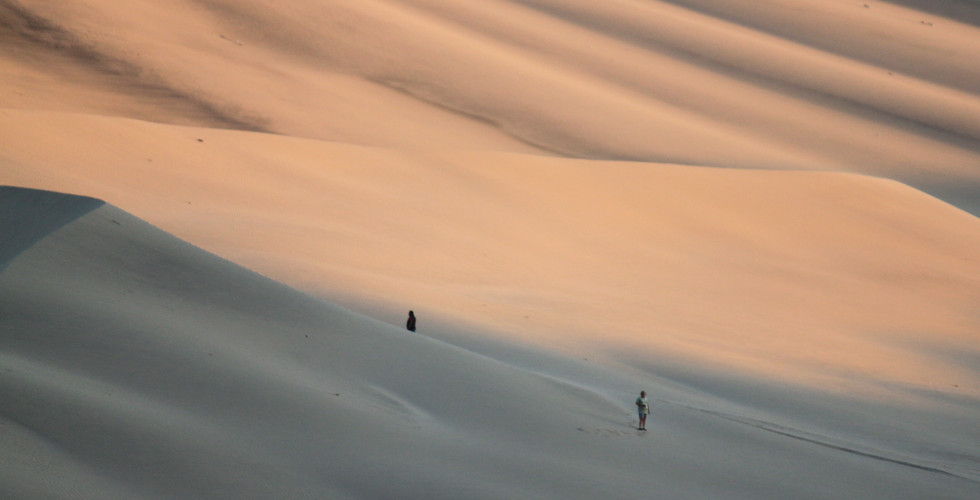Peru IV: The Wurst Of Times
- Yvonne O'Connor
- Jun 3, 2020
- 8 min read
It’s May, winter is coming and lockdown mornings rise under a cold, white sky. Sometimes there’s fog on the dunes. After freezing over a cup of coffee we walk our circles inside the walls. This 65 minutes of self-righteous energy is later undone by eating the hotel breakfast which we managed for 8 solid weeks before coming to our senses. I don’t think the salchicha was ever within spittin’ distance of a pig but it didn’t taste bad and the huevos definitely came from a happy hen. While it kept us going till lunchtime it wasn’t healthy and it never, ever varied. In the end we decided if Covid didn’t get us, the pink, fatty offal tubes would.
It feels ridiculous to begin the day wearing a coat and scarf and without moving more than a few feet be barefoot and in shorts by 10 AM. Still, it saves on the laundry. The only thing wrong with this hotel is there’s no washing machine. It doesn’t even have one of those big stone sinks you usually find in Latin America. Instead, our lavanderia is a pink bucket and a shallow sink with no plug in the garden. The bucket gets all Fran’s clothes after each shopping expedition. Recently he thought it a good idea to add a dollop of bleach. All went well except for his grey shirt which is now a salmon pink with grey tie-dye. It’s an assault on the eyes, like a Rorschach test for a Woodstock survivor. But ever the optimist, Fran says it reminds him of his hippy days and better still, if he ever feels the virus coming on, he can eat it.
Every Thursday he gets suited-up to go ‘outside’. Hailing a taxi from the main road is now allowed which saves on the home pick-up that early quarantine required. We still aren’t allowed to drive our own vehicles and the fine for being out on a motorbike is 6,000 soles (USD 1,765). In this economy that’s a staggering amount of money. Personally I don’t see why sitting with a possibly-infected stranger in an illegal taxi that avoids checkpoints is a safer way to travel than going solo in your own fully-permitted vehicle but ours is not to reason why. Tuk-tuks are now a legal option and those guys can spot a gringo a mile away. They’re almost halfway to the supermarket before the drivers come down to a realistic price. Sometimes they’re in terrible shape, the tuk-tuks, and Fran is in terrible shape by the end of it. The last one generated so much black smoke and fumes he nearly asphyxiated in the back seat. Others have zero suspension and it’s always a gamble whether the eggs will survive the main roads before they turn off onto the more forgiving sand.
Food costs have risen steadily. The weekly bill is now just under double what we were paying in March. The produce is increasing the most and there are sometimes shortages, like wheat flour, so we’ve been using maize flour instead. We’re making a lot of arepas which is what happens when you hang out with Venezuelans all the time. They’re a great invention, just mix flour, water and salt and ten minutes later they’re ready to be slapped together and put on a hot pan. Scarli makes hers so perfect I bet she popped out 27 years ago and said “Take me to your griddle”. We used to eat them sizzling hot off carts on the sun-drenched streets of Cartagena, strolling and licking our fingers under wrought-iron balconies and cascading geraniums. Just thinking of those days makes me want to weep.
Between us four guests and the managers, we comprise six cuisines: California, Ireland, Spain, Chile, Venezuela and Colombia; you never know what’s coming out of the tiny kitchen. The Venezuelans eat lots of rice, beans, fried plantains and meat (in other words, our diet of the past 1.5 years). Last week they gave us a cup of beans with a pig’s trotter. They also make Andean potato soup, for breakfast. This is another staple we ate a lot of in Colombia. The freshness of the cilantro would make your hair stand on end though I never did get used to soup first thing in the morning. Melissa and Enrique take the prize with their breakfasts of pureed oats and fruits in nut or chocolate milks, topped decoratively with chia or linseeds. It makes me want to defect to the other camp.
Cooking was a harmonious affair until Fran brought home red peppers that he thought were Bell. When he began to roast them our eyes streamed and our throats burned, but they tasted good so the next week he bought some more. The hot sauce was made and in the fridge when his palms got red and next thing he was washing his hands every few minutes. Fran has a high tolerance for pain but he was pacing and flailing and at one point he thought he’d pass out and had to lie down. That’s when Deiby the manager went outside, taking a big kitchen knife with him. He came back with long aloe leaves, slashed them open lengthways and put the gel from inside on Fran’s palms. It worked, slowly the pain eased, especially after we put the leaves into the freezer. I saw the plant the next day, small, dusty, sitting across the street in the sand beside a cactus. Later, clutching a cold can of beer (for purely medicinal purposes) the patient remarked that he now knew why the checkout lady asked if he was sure he wanted six Rocoto peppers. After looking them up on the Scoville scale I was just relieved he got fixed without outside intervention (for perspective, Jalapeno peppers are 2,500–10,000 units while Rocotos are 100,000-350,000). We’ve been remarkably lucky on our journey so far. If you discount the Belizean blowfly living in Fran’s head, I’d say well gosh, we’ve never been healthier!
Click Arrows For Slideshow:
On May 4 the government approved proposals for easing the lockdown and introduced a 4-phase reopening of the economy. It would begin in mid-May but nothing much changed for us. We still had nightly curfews, Sundays continued to be out of bounds, masks and distancing were required with fines for those who broke the rules. We are still only allowed out for food, money or medicine, and only one family member can do that. While there was no mention of adults, children can now exercise for 30 minutes a day with a parent, no more than 500m from their homes. The bad boys of Tumbes, Piura, Lambayeque and La Libertad, all northern departments we visited in February, haven’t changed their ways so their curfew remained at 4 PM to 4 AM, as did the jungle state of Loreto. Outside the silence of the past weeks was beginning to break like a slow crack. It was only when we heard a couple of military planes overhead that we realized how long it had been since we’d seen any aircraft. There was the odd car engine too, and the morning cries of a bread seller but mostly it was a gradual reopening of industries like mining and construction, and approved restaurants could begin pick-up and delivery services. In June they planned to restart internal travel while international borders would open in July.
April’s last grocery run brought good news; the barricades had been removed from the booze aisle. There was a generous limit per person and All-Purpose flour was back too so there were celebrations on returning to the homestead. He doesn’t practice it but Fran is a great admirer of “Frühschoppen”, the German custom of drinking in the morning. I myself am more in awe of a culture that actually created a verb for such an activity. There’s a little bar beside the pool with shelves of half-filled Bailey’s and Pisco bottles. Nobody ever uses it but in week 9 Fran invited me over for a glass of wine. It was lovely to sit there and contemplate the dunes from another angle. I tried the old pick-up line “Do you come here often?” but he was busy bonding with his beer. Never mind, it was like a real night out, with real conversation. And then he walked me home.
The 4-Phase plan was good news and while we’d no intention of being first out the gate the minute travel restrictions were lifted, it was encouraging to think we were at a stage where actual dates could be set. But I’d been watching the Covid-19 numbers and things seemed to be getting worse, not better. I put it down to the increase in testing but then we read about the markets. Screenings had been carried out around the country and in the eighth week of lockdown 79% of vendors in Lima’s Fruit Market tested positive for Covid-19. Other markets didn’t fare much better at 45% to 61% and in the Peruvian Amazon, almost 100% of traders in Iquitos’s Bethlehem Market were infected. Iquitos is the largest city in the world that can’t be reached by road and with limited air deliveries of supplies the area was described as a catastrophe. On May 20 we passed 100,000 cases and the reopening plan seemed a pipe dream.
Meanwhile, facing unemployment and starvation, many of Peru’s informal workers, most of them in Lima, were desperately trying to get home to their villages hundreds of miles away. They queued for buses or walked along main roads with babies and children, bringing the virus with them. Over 70% of the workforce here is in the informal economy and their work stopped as soon as the lockdown went into effect. We’ve seen the same people everywhere since crossing into Mexico. They’re the ones selling ice cream out of carrier bags, sunglasses on boards strapped to their chests, even single strips of chewing gum, and if they’ve nothing to sell, they sell themselves. You think you’ve seen it all until you pass a four year old juggling balls in front of a line of stopped traffic. The government stimulus package didn’t reached half of them. In spite of the good intentions there can be no doubt there was a lack of planning for the steps following the shutdown. Battling an outbreak of dengue fever at the same time also didn’t help.
Click Arrows For Slideshow:
Just before our May 24 deadline we were told the state of emergency and quarantine would remain in effect until June 30. The loosening of restrictions from earlier in the month stayed put but in an embarrassing development our department, Ica, joined the bad boys of the north and our curfew hours were reduced to 6 PM to 4 AM. The big Resumption of Activities was put back. The travel dates are the ones we’re watching closely. Inter-Peru travel is now scheduled for July/August and the reopening of international borders and airports won’t happen until Phase 4, which is September/October.
We’ve always felt safe here with Peru’s early and strict action but the rapid increase in cases and deaths is disheartening. We are now one of the worst hit in Latin America, second only to Brazil. It’s definitely not where we expected to be eleven weeks into the state of emergency. As each lockdown period was extended, we assumed things were on their way to reaching a point of control. What we forgot is the real life that’s still out there. We were able to step away and hide but a lot of people couldn’t.
Even when I’m not walking round in circles, my mind is. It’s been reduced to a toy train, one on a big meandering track, clicking off stops and contemplating alternative destinations only to find myself back where I started, and worse, still in the same living room. We’ve no idea where we’ll be in six or twelve months’ time. That’s nothing new, this whole trip has been lived like that but now, where we go depends on other people’s decisions, not ours. We know what we’d like to do, and what we probably won’t do but not what we will do. A lot depends on what we are allowed to do and when. Everything depends on the land borders around us. Our biggest fear is a grand reopening of the economy, one that happens not because the government’s got a handle on the pandemic but because they don’t want to play this game anymore. It’d be like my morning sausage, you can call it what you like: chorizo, salchicha, wieners or wurst but underneath the neat and edible packaging it’s still the same mess of unpleasant bits that none of us want to think about.












































Great update Yvonne! You captured your circumstances so well, we feel like we are there. We also hope the borders open up for us boarders for the right right reasons. Chao from Argentina!
Well, your calling card and sticker never made it beyond my office desk, with the effect that they sit and stare at me every day, reminding me to think beyond life in the UK, to how you're coping in a nervous C-19 a world. Who knows how the simple pleasures of travel will be re-calibrated? Anyway, we love reading your updates; Yvonne's word-smithing art really does bring your adventure to life. Stay safe you two ...
Oh man..... I'm really glad you two are safe, and I'm also saddened to hear you are unable to travel. I am sure it is hard to stay in one place that long. It puts things in perspective for me in the US. Hopefully you are able to figure out a plan soon. We think about your guys often, and I enjoy the updates. Please continue to keep letting us know how it is going! Take care.
Really enjoyed reading the latest edition, beautifully written, well done.
Hi Yvonne & Fran,
I had no idea that Peru is now as bad as Brazil. We here about Brazil here in the US, but not much news about Peru. The good news is that liquor is readily available now. I really laughed about your "date" night with Fran. I love how you can find your sense of humor even after being in lockdown for so long. I felt your frustration over how the future is so uncertain and seemingly no longer up to your desires. I didn't remember that at a minimum the stay-at-home orders would go to at least June 30th. I must admit, I never thought about you not having a washing machine or at least…